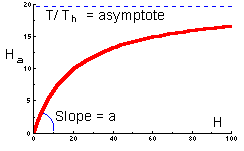
Premise: the rate of prey consumption by a predator rises as prey density increases
But, what is the functional form of this rise and what are the limits? For instance, is it linear (Y = ax +b) are might there be other issues?
What might some of the variables be to consider:
Let's think about predators - what do they do? 
This handling time concept now limits a predators consumption rate, espcially if the handling time is large.
The total predator time is
T = Tsearch + Thandling
Now let's specify Ha as the amount of prey captured by the predator during time T (this would be an integer number). The little a refers to "attack".
Since handling time should be directly proportional to prey capture rate we have:
Thandling = HaTh
where Th is the time spent on handling of 1 prey.
What is the capture strategy of a predator?  Mostly
random. A predator hunts around some area over some time interval and
so there is a "search rate" parameter which we will call a which
has units of area/time (e.g. meters2/seconds)
Mostly
random. A predator hunts around some area over some time interval and
so there is a "search rate" parameter which we will call a which
has units of area/time (e.g. meters2/seconds)
After searching for some time, Tsearch, a predator has covered an area of:
aTsearch (meters2/seconds x seconds = meters2)
(meters2/seconds x seconds = meters2)
and has captured:
aHTsearch
prey, where H is the prey density per unit area (N/area).
So,
Ha = aHTsearch
or
aTsearch = Ha/H
and
Tsearch = Ha/aH
Now one evaluates the total time budget
T = Tsearch + Thandling = HaTh + Ha/aH
We are interested in expressing Ha as a function of H and T.
for the asymptotic case where aHTh >> 1 then Ha = constant = T/Th
This equation has a functional form that looks like this:

How does one interpret this?